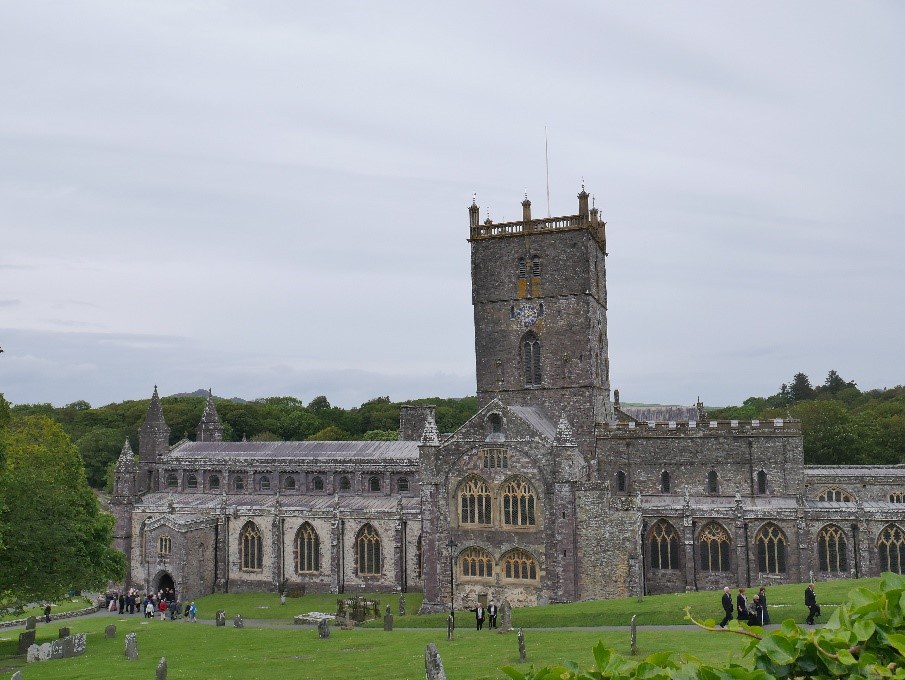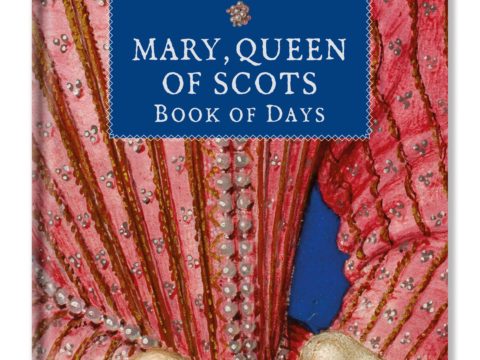St David's Cathedral
Chapter 1: History

St David’s is a tiny city, with a vast history.
St David, or Dewi Sant in Welsh, is the patron saint of Wales. Born in around 500 AD, he founded a monastery in 559 AD at the westernmost tip of South Wales, which later gave rise to a bishopric, with primacy over Wales, and the concomitant cathedral and bishops’ palaces in the city of St David’s/Ty Ddewi itself and in Lamphey/Llandyfai, around thirty miles distant.
As the home of a cathedral, St David’s is a city, although a tiny one. It attracts both tourism and pilgrims – in the Middle Ages, two pilgrimages to St David’s was worth one to Rome, and three visits was the equivalent of the trek to Jerusalem itself.
The city is charming – well-set-up for tourists with plenty of eateries of various sorts, the usual array of gift shops and several outdoor and surfing shops, suited to its location on the famous Pembrokeshire Coast Path, and with superb beaches within a few minutes’ drive.
St David founded his monastery in the valley of the River Alun, choosing, according to legend, the spot where a spring gushed forth when he planted his staff in the ground. St David’s Well still exists, although it is now under the current cathedral building.
Whilst West Wales today seems remote, during St David’s lifetime, in the century after the Romans left Britain, there was constant sea-going commerce through the Irish Sea, linking modern Wales, Ireland, Cornwall and Brittany in their resistance to Anglo-Saxon invasion. David himself is traditionally thought to have been a descendant of Cunedda, King of Gwynedd (North Wales) as well as of the King of Dyfed, the kingdom within which St David’s is situated. His mother is named as Non, daughter of a local chieftain, who bore David as a result of rape.
These traditions come from the early life of St David, written some 500 years after his death on 1st March 589 AD or possibly 600 AD. His hagiographer, Rhigyfarch, was the son of Sulien, Bishop of St David’s, who lived in the late eleventh century – clerical marriage was permitted in the Celtic church.
In the 500 years between David’s life, and that of Rhigyfarch, the monastery that the saint founded followed a deeply ascetic way of life, including vegetarianism, and the eschewing of farming using draught animals – the monks did all the hard labour themselves. When not toiling in the fields, or praying, the monks of St David’s developed a reputation for learning. They were early keepers of chronicles, beginning in the eighth century, and recording the depredations of the Vikings, both in the Welsh kingdoms and in neighbouring England. Following the Viking raids in the Saxon kingdom of Wessex, its monarch, King Alfred, requested the then bishop of St David’s, Asser, to help him in regenerating scholarly life.
St David’s, too, suffered from Viking raids – two of its bishops were slaughtered by the marauders – Morgenau, in 999 AD (it was suggested that his death at the hands of pagans was a punishment for eating meat!) and Ambrose in 1080. The monastery was destroyed and rebuilt repeatedly. The oldest stone currently known is part of a tenth century grave marker.
Rhigyfarch, as well as wishing to promote St David for religious reasons, was also making a political statement. During the latter half of the eleventh century, after William of Normandy conquered England, he encouraged his followers to encroach on Wales, with the promise that they could keep any land they took from the Welsh princes on more favourable terms than the land they held in England. The Normans were strong supporters of the Roman hierarchy in the Catholic church, about which the Celtic church was rather more ambivalent – hence Rhigyfarch’s efforts to emphasise the long history of the bishopric.
The conquering Norman lords became known as the ‘Marcher’ lords, and, by the end of the eleventh century they occupied much of Pembrokeshire, as well as the border regions between the two countries. William the Conqueror visited the shrine in 1081 – possibly as a pilgrim, since he considered himself very devout, but probably also to assess the vulnerability of attack from Ireland. During this period, many of the lands of the bishopric were taken by Normans, and granted to their own monastic foundations, in other parts of Norman-held Wales, in England, and even in France.
By 1115, the English king, Henry I, had enough power in the region to impose his own choice of bishop on the diocese. He chose Bernard, formerly chancellor to his wife, Matilda of Scotland, herself the daughter of St Margaret, and gave the bishopric the status of a Marcher lord.
Bishop Bernard proved to be the archetype of the reforming, energetic, controlling Norman bishop. He began a new cathedral building, probably at the eastern end of the current structure. He was hampered, however, by the lack of holy relics. Although Rhigyfarch’s 'Life of St David' says the saint was buried in his own monastery, no-one could find his remains. In an impressive tribute to Bernard’s genuine piety and probity, he refrained from inventing a find, but persuaded Pope Calixtus to grant the pilgrimage status mentioned above to St David’s even without any relics. Such relics of St David as still existed in the 1100s – his staff, his Gospel book, a bell and a portable altar – were jealously guarded by the churches which held them.
Fortunately, the saint made his whereabouts known in 1275, in a dream given to the Prior of Ewenni, John de Gamage. As instructed, he dug somewhere to the south of the cathedral, and discovered a body, immediately recognised as that of the saint. The bones were enshrined with those of another local saint, Justinian, under a painted timber ceiling, with images of St David, St Patrick, and St Denis to the fore, with receptacles for pilgrims’ offerings.
Bishop Bernard was followed by Bishop David FitzGerald, grandson of Rhys ap Tewder Mawr, d. 1093, the last king of Deheubarth, who had granted extensive lands to St David’s. Bishop David’s mother, Nest of Deheubarth (one of Henry I of England’s many mistresses) bore numerous children to her husband, Gerald of Windsor, giving rise to the FitzGerald clan, pivotal to Irish history. Bishop David’s nephew was the famous Gerald (Gerallt) of Wales, or, to give him his Latin name, Giraldus Cambrensis, whose prolific writings give historians most of the extant information about the late Norman age in Wales and Ireland. Despite his ambition to be Bishop of St David’s and being elected twice, Gerald was refused recognition by Henry II of England, and then by King John. He had more success in spearheading the construction of a new cathedral building, approved by Bishop Peter de Leia, much of which still stands.
